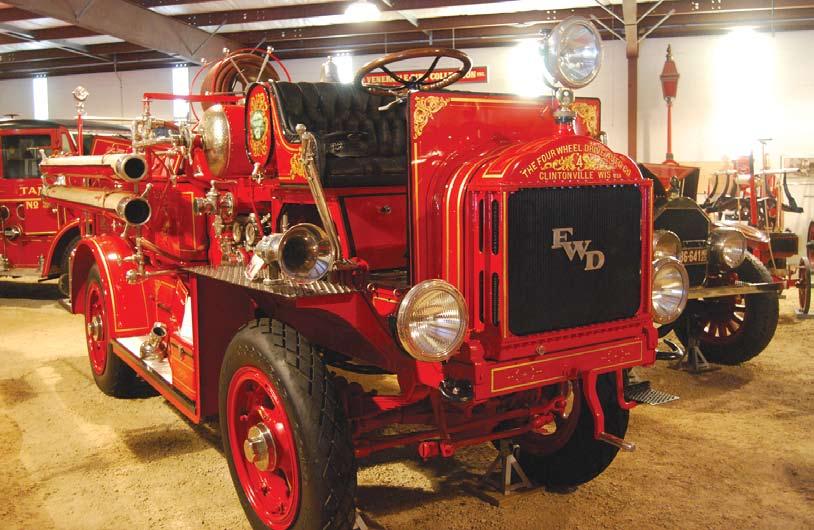
10 minute read
4x4 Fire Trucks
Story and photos by John Gunnell

Advertisement
Probably the first four-wheel-drive fire truck ever made was a 1911 tractor built by the Couple Gear Freight Wheel Equipment Co. of Grand Rapids, Mich. But it was not really made to be used off road. The Couple Gear tractor had an electric motor on each of its four wheels that helped it pull a water tower that was formerly pulled by horses. The water tower was pulled like a trailer and not likely to be used to put out a brush fire. In 1917, the Four Wheel Drive Auto Co. (FWD) of Clintonville, Wis. delivered its first motor-pumping fire engine to Minneapolis. Fire truck historian Walter McCall’s American Fire Engines since 1900 (Crestline 1976) says, “The pug-nosed FWD fire truck quickly acquired a reputation for being able to traverse almost any kind of ground.”
That same year, the Tulsa, Okla. fire department began using a four-wheel-drive Nash Quad as a rescue squad truck. Many FWDs and Nash Quads built for the United States Army were available as low-priced war surplus vehicles after World War I ended.
In 1926, under the direction of master mechanic William F. Stiebel, the Milwaukee Fire Dept. started to build its own fire trucks instead of using factory-built trucks. The earliest of these had Timken axles, but later versions designated MMFDFWD models used FWD axles. These 4x4s were extremely well-built and comparable to factory trucks. Although they utilized the four-wheel-drive technology, many had dual rear wheels.
By 1930, FWD was building a few “four-wheeldrive” fire trucks each year. In 1930, the company turned out a small pumper on a 1929 FWD chassis for the town of Lead, S.D. It had a Waterous pump and was starting to resemble a go-anywhere brush truck that could carry water into a brush fire or forest fire and pump the H2O out on it.

Waukesha-powered pumpers. Delafield, Wis., bought one of the new FWD fire trucks in 1940. It had updated styling, a two-man cab and a 500-gal. pump. The FWD chassis was usually seen under trucks used in heavy-duty construction and off-road work, but the ability to travel off road came in handy in fighting fires as well. Prior to World War II, industrial designer Brooks Stevens, of Milwaukee, Wis., did work for Willys-Overland, the Toledo, Ohio company that built WWII army Jeeps. During the war, he was asked to come up with design concepts for postwar Jeeps and he dreamed up an all-steel station wagon and pickup truck. When they went into production in the late-1940s, some of these were turned into fire trucks. With their four-wheel-drive capabilities, they were found extremely suitable for fighting brush, field and wild fires. The universal Jeep was also suitable for certain firefighting applications in the early postwar era. American Fire Engines since 1900 shows a 1954 model used by the fire service in Ocean City, N.J. It had a deluge gun on front that sprayed water on a fire while the Jeep The Blitz Buggy Co. of Old Forge, N.Y. started converting light-duty trucks into small fire service vehicles that were forerunners of today’s mini pumpers. They carried a water tank in the bed, twin booster
reels and enough hose line and equipment to handle moderatesized fires. Many of these small trucks also got four-wheel-drive conversions by Marmon-Herrington, Coleman or NAPCO so they could fight fires in fields and woods.

According to www.coachbuilt.com, the Blitz Buggy was the creation of Walter L. “Army” Armstrong, a WWI naval veteran who had them built at E. L. Brussel’s Thendara Garage, in Thendara, N.Y. The Blitz Buggy name comes from the WWII Bantam Jeep’s nickname. They were based on 1- to 1-½ ton Chevrolet, Dodge, Ford, GMC

and Willys-Overland light truck chassis and marketed to small-town airports and fire departments under trade names including Blitz Buggy, Little Demon, Jet, Saginaw and Little Mo.

Coachbuilt discovered that Armstrong dealt with regional fire fighters through Army’s Fire Service, a fire equipment distributorship he ran. With the assistance of Town of Webb supervisor Philip W.
Burdick (1896-1971) and his brother, Charles (Charlie) Burdick, Armstrong embarked upon the manufacture of his own line of apparatus in 1949.
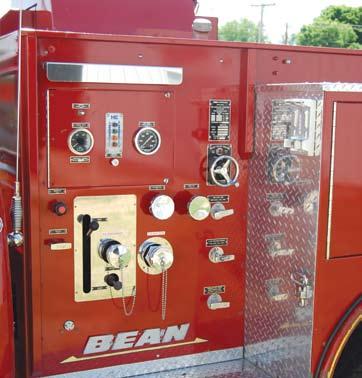
The Blitz Buggy and the Little Mo were devised to assist local volunteer fire fighters who protected acres of brush, forest and parklands. When equipped with an onboard foam system, they were perfect for use at small airports. Forty-six units were sold between 1949 and 1956 with 11 on 1-ton Jeep chassis. The later Little Mo was available on the Dodge W200 and W300 chassis. One based on a 1959 Dodge Model 205 with four-wheel drive and marketed by American LaFrance is pictured in Walter McCall’s book.
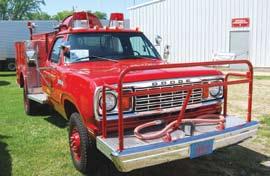

The 1959 Dodge Little Mo was powered by a Chrysler Corp. V8 and designed for airport runway service. It carried a 90-gallons-perminute roof turret, a 200-gal. water tank and separate tanks for 20 gals. of anti-foam liquid and five gallons of wetting agent. It also had 150-ft. lengths of booster hose on each of two reels mounted behind the cab. These trucks were truly the progenitors of the fourwheel-drive brush trucks of today.
A brush fire or field fire--usually called a wildland fire today—can be very dangerous. One spark landing in a dry field can erupt into a conflagration that destroys acres of vegetation in no time. Fighting a brush fire requires a specialized fire truck that can negotiate rough terrain to reach the area where the blaze has started. Such fire trucks are typically smaller than a standard pumper or ladder truck, but may have greater ground clearance underneath the vehicle to clear terrain, large rocks and fallen limbs.
Brush trucks can respond quickly and efficiently to fires no other apparatus can reach. Many have a four-wheel-drive chassis to improve their hill-climbing and rough terrain capabilities. The best brush trucks can pump and spray water while in motion, whereas traditional fire engines must be stationary to pump water. When the brush truck arrives on scene, its mobility does a great deal to minimize the fire’s rate of spread.
Fire departments that serve areas along the outskirts of a very rural area often prefer combination fire engines that combine the features of a standard fire engine with those of a brush truck. Of course, any truck can do more with off-roading capabilities.
In the early 1960s, the Chicago Fire Dept. had a couple of interesting four-wheel-drive fire trucks built. They were constructed on the larger 1-ton forward-control Jeep chassis designated the FC-170. Two were special smoke-ejector trucks made by John Bean of Lansing, Mich. They carried large round tubes. These were accordion-folding smoke pipes that could be set up to suck smoke and gas fumes out of burning buildings.
Chicago F.D. also had another FC170 set up as a high-pressure turret wagon that could be driven right into a burning building (or a burning field). The 4-way deck monitor could flow enough water to douse pretty scary flames. It was called “Jeep Pressure 1.”
Off-Road Behemoth
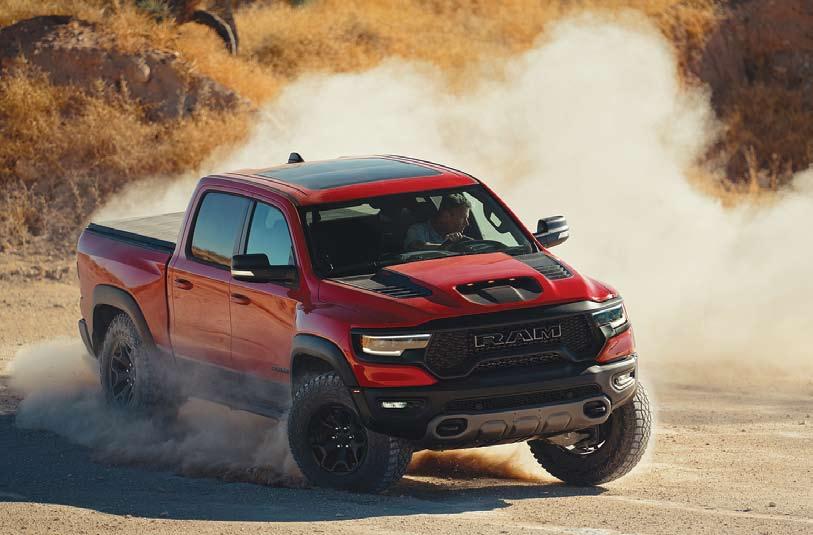
2021 Ram 1500 TRX
Story and photos by Dan Heyman, photos courtesy of FCA Canada
Who here remembers the Dodge Ram T-Rex? Nobody? One? Two? Bueller?
Well, the T-Rex was a concept pickup from 1997, whose main party trick was that it had three axles. It was like a cross between a standard Dodge pickup and the 6x6 WWII-era Dodge WC trucks that did almost as much work as the venerable Willys Jeep, but received about a tenth of the notoriety.
Dodge never made the T-Rex available to the public (though you could virtually drive one in the Test Drive Off-Road video game which came out about a year after the T-Rex debuted), but they have now scrapped the hyphen and the “e” and come out with something even crazier that will, in fact, be available in Ram dealerships all over North America.
It’s called the TRX, and it’s a Hellcat supercharged V8-powered, towing, hauling and offroading behemoth that makes about as much sense as…well, coming out with yet another Jurassic World movie, I guess.
The thing is, though, “sensibility” in the car and truck world – well, in the performance car and truck world, anyway – is not really something we harp on too often. No supercar or hypercar makes practical sense, really. That’s because they’re not supposed to, and because “sensibility” is boring and not all that much fun. However, being able to traverse “harsh terrain” at over 160 km/h sounds like a whole heck of a lot of fun. As does 702 horsepower, 650 lb-ft of torque and specially-tuned off-road dampers from Bilstein. Oh, and a “Baja” mode that tweaks the suspension, 4x4 system and powertrain for those who want to hit “maximum attack trophy truck” mode out on the sand, snow and mud.
Of course, we’ve seen a “Baja” mode before in the Ford F-150 Raptor (and will do so again; rumour has it that Chevy’s about to release an extreme version of its Colorado pickup that will also get a – yep – Baja
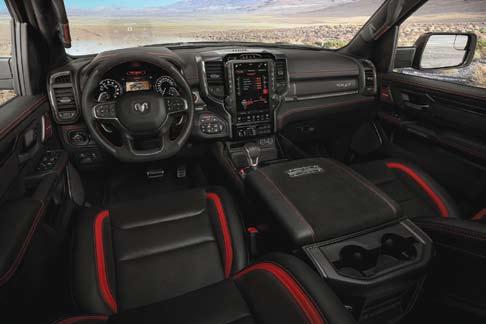

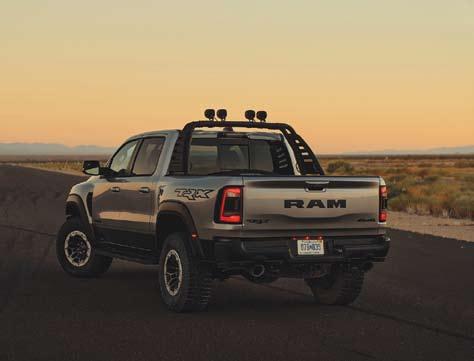
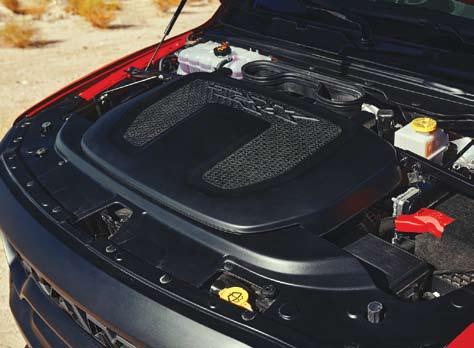
As ornery as the TRX looks, though – and we’ll delve further into that in just a moment – it is a pickup, and as much as one likes to drive in Baja mode across sand dunes at 160 km/h, a pickup has to work, too.
To that end, the TRX is good for towing 8,100 lbs and hauling 1,310 pounds in its 5.5-foot bed (the TRX comes only as a quad cab with 5.5-foot bed). Add a 3.55 Dana 60 rear axle and 2.64:1 crawl ratio, and bespoke 35-in. Goodyear Territory rubber, and you’ve got kind of an all ‘rounder here.
Looks like anything but an all-rounder, though, and it starts with that massive ground clearance and massive girth. Girth that’s been increased by 203 mm over a standard Ram 1500 courtesy of some carbon fender flares for a total 2,235 mm. That increase allows the fitting of 229 mm wheels, which themselves represent a 26 mm increase in width.
Other body swelling comes courtesy of an enlarged grille and hood bulge, each opening responsible for 50 percent of the air flow into the engine, which is crucial for an engine this big. In case that wasn’t enough, Ram has gone ahead and fitted a string of LEDs to each front fender and to the hood scoop. That’s all stock; Ram says that FCA’s Mopar tuning arm is already hard at work developing over 100 bespoke parts for the TRX, from off-road lights to a trophy truck-style bed-mounted spare tire.
Inside, the TRX comes in two colourways: black and suede, or black with red and carbon inserts. Other interior tweaks include an SRT-style flat-bottomed wheel and standard fitment of the massive 12-in. Uconnect infotainment screen previously seen on some Rams. New stuff includes an optional digital rear view mirror, and you can opt for a heads-up display, too.
That Uconnect screen can be split in two, allowing occupants to mix-and-match various displays; you can have your Apple CarPlay in one spot, and your navi in the other. Or, you can go full-data and choose to display both your Off-Road pages (insights to your angle of attack, wheel articulation, etc.) and SRT Performance Pages (G’s undertaken, acceleration times and so forth) at the same time. The TRX, meanwhile, marks the first time we’ve been able to display those info pages on the main display, as they’ve hitherto been limited to the in-gauge TFT cluster. Which is also here, and can still display the Performance Pages and Off-Road pages.
To top it all off on the display front, there’s a forward-facing camera that looks down at the terrain below you so when you’re climbing steep hills and can see nothing more than the great wide open through the windshield, you can glance at the infotainment display to see what’s going on below the wheel. Or if there happens to be some exotic Saharan beast crossing the path ahead of you.
If all that’s not quote special enough for you, Ram is building 100 TRX Launch Edition trucks for Canada, which bring special exterior colouring, an interior number plaque and…not that much more, really.
Pricing for the 2021 Ram TRX starts at $93,995 for the standard version, and $114,995 for the Launch Edition.





